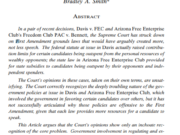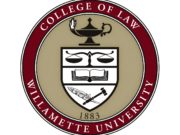More than a year ago, we dissected the original proposal from the “Bright Lines Project” to reform the IRS’s rules governing the extent to which tax-exempt organizations may engage in political activities. Our verdict at the time was that the proposal not only failed to live up to its promise of providing bright-line rules that are easy to understand and to administer, but the proposal also was unduly restrictive of non-profits’ political speech rights. Now the Project has come up with a repackaged version of its proposal, which it has formally submitted to the IRS. While Bright Lines 2.0 is marginally better in some respects, it is still built on the underpinnings of Version 1.0 and suffers from most of the same bugs.
Starting with the outside packaging, the Project’s cover letter to the IRS touts Version 2.0 as “making a complex subject simpler and easier to follow.” The Project’s authors begin by enticing us with the prospect of just “four pages” of rules that “contain the heart of the matter” – “a succinct operational tool,” they claim. “But wait” – as they say in the infomercials – “there’s more!” Those four pages are just a teaser, to be followed by “a dozen pages of definitions,” which are integral to the rules. But it gets even better – if you’re a glutton for regulation. On those dozen pages, we’re braced to expect “a series of definitions (28 total) . . . with some subsidiary terms defined within others.” Even all that understates the proposal’s intricacies. A fairer characterization would read: Sixteen pages of dense, single-spaced, lawyerly regulatory code of such complexity that many of the 28 defined terms need their own additional subsidiary definitions.
At least the Project’s authors are no longer calling their main tenet the “General Speech Rule,” with all of the attendant implications of that Orwellian-sounding term. But this rebranding doesn’t change the fact that the latest Bright Lines proposal still puts the IRS in the position of being the speech police.
Taking to heart the adage to never judge a book by its cover, let’s peel away the wrapper of the Project’s second iteration and take a closer look inside. The general architecture consists of: (1) certain activities that are per se political intervention, and which are generally prohibited for 501(c)(3) charities and restricted for all other 501(c) organizations; (2) certain safe harbors that are not political intervention; and (3) all other activities, for which a rough-and-tumble, multi-factor, and virtually boundless “facts and circumstances” test will still be used to determine whether an activity is political intervention – a la the IRS’s current approach.
As with the original proposal, one commendable feature of the latest proposal is that evidence of an organization’s “intent, motive, or desire” to engage in political intervention still may not be considered, which at least prevents the IRS from becoming the thought police in addition to being the speech police. Regrettably, however, another carryover from the original proposal is that “the organization bears the burden of proof to demonstrate more probably than not” that its activities are not political intervention under the facts and circumstances test. This inverts the traditional principle of American law that defendants are presumed innocent until proven guilty and should not be forced to prove a negative.
The proposal insists that “no presumption that the activity constitutes political intervention shall arise from the fact that the activity is not within a safe harbor.” But how can there not be such a presumption when the rule otherwise places the burden on the responding organization to prove a negative? Are we really to believe the IRS will simply leave a matter in limbo, or dismiss a complaint alleging improper political intervention, when an organization fails to meet its burden under the proposed rule of demonstrating that its activity was not political?
Moreover, in his plurality opinion in Wisconsin Right to Life II, Chief Justice Roberts admonished that, “Where the First Amendment is implicated, the tie goes to the speaker, not the censor.” The Bright Lines proposal fails this constitutional standard by imposing a preponderance standard on the speaker even in cases where the evidence is a close call.
Having perused the overall framework, we come to the specifics of the latest proposal. The following is just a sampling of some of the more confounding problems that Bright Lines continues to present:
- Generic Advocacy as Explicit Advocacy. As with the first version, the proposal continues to treat as per se political intervention activities that “explicitly advocate” for individuals to support or oppose candidates based on broad criteria, such as “positions on certain issues,” even if the organization does not reference specific candidates, or associate specific candidates with certain issues. Thus, for example, if Planned Parenthood generally urges its supporters to back “pro-choice” candidates, that would be political intervention, even though the Supreme Court has never treated these general exhortations as “explicit” or “express advocacy.”
Moreover, the latest proposal, in an apparent nod to political correctness and identity politics, adds “characteristics such as gender, age, race, or religion, or any other criterion or qualification” to the mix. Thus, if the League of Women Voters were to generally exhort its members to support women candidates, or if the Human Rights Campaign were to generally urge its members to support gay and lesbian candidates, those activities also would count as political intervention.
- “Know It When I See It.” As with the first version, the latest proposal continues to treat as per se political intervention activities that refer to and “reflect a view” on specific candidates, when conveyed through paid mass media advertising and accompanied by a reference to an election. The latest proposal adds that “content, tone, and images” will determine whether a communication “reflects a view” on a candidate. A communication’s “tone” is not something that is easily ascertainable with metaphysical certainty, as demonstrated by skeptical reactions to the Secret Service’s recent plans to acquire software to detect sarcasm on social media. Rather, it often entails a “know it when I see it” determination. Will organizations now have to retain expert witnesses on linguistics to testify about the tone of their communications? And what about the tone of music used in communications? Presumably that would count as well under the rule, so music theory experts also will be needed.
- Censorship. As with the first version, the latest proposal continues to treat as per se political intervention communications that “refer to and reflect a view” on a candidate’s policy views if they are disseminated in “close contests” during the election year in which the candidate is running.
One way to make politicians see the light on an issue is to make them feel the heat of public criticism. Or, if a politician has taken a courageous stand on an issue, public praise for the politician’s position can provide reinforcement and encourage others to adopt the same position. Swing votes on a legislative issue are highly correlated with politically vulnerable incumbents. Treating all hard-hitting lobbying ads, even those run months in advance of an election, as per se political intervention is simply wrong. It greatly harms single-issue groups whose issues may come up at a time during which all such speech is treated as political intervention.
The Bright Lines authors might respond that their proposal only covers “targeted” communications, but under their definition nearly every communication could qualify as targeted.
The proposed rules also define a “close contest” as one in which, among other factors, the candidates are separated by ten or fewer percentage points in publicly reported polls during the prior 30 days of a communication. An organization that invests substantial time and money in preparing an issue advocacy effort in the middle of a race that previously hadn’t been competitive is thus out of luck if the polls suddenly tighten. Due to the unpredictability of polling, the likely real-world effect is that this rule will deter constitutionally protected speech about public policy issues in all jurisdictions, regardless of whether the polling is close at a particular moment. Moreover, the proposal fails to clarify how to treat a race in which one poll shows a 20 point spread and another shows only a difference of 10.
- Black-Out Periods. As with the first version, the latest proposal continues to rely on the timing of an organization’s activities under the facts and circumstances test to determine political intervention. The latest proposal sets a bright line (but not in a good way), whereby communications that refer to a candidate, do not consist of paid mass media advertising, and do not refer to an election will not be presumed to be political intervention, but only if they are made prior to the calendar year of a candidate’s election. This is a far broader black-out period than even the 30- and 60-day “electioneering communications” periods under the federal campaign finance laws, worse than the highly criticized (and rescinded) rule proposed by the IRS last year, and gives public officials that much more time to act with diminished accountability to public interest groups when they’re facing reelection, which is generally when they should be most attuned to public opinion.
President Obama’s evolution on the issue of gay marriage during the 2012 election is a perfect example of how the election season is often the prime window for influencing politicians’ views. But under the Bright Lines proposal, gay rights groups that put public pressure on President Obama in the months leading up to his announcement of his support for gay marriage would have been engaged in restricted campaign activity. That doesn’t seem right.
- Candidate Pledges, “Comparative Voter Education,” and Internal Contradictions. As with the first version, the latest proposal continues to give differential treatment under the facts and circumstances test to candidate pledges, where organizations ask candidates to pledge their support for certain policies. (The Americans for Tax Reform’s tax pledge is a prominent example of a candidate pledge.) Under the Bright Lines rule, if all of the candidates for a given office have the same stance on a pledge, then the organization may publicize their stance; but if they give differing responses, then the organization must justify why publicizing their positions is not political intervention.
As a preliminary matter, whether or not an organization’s issue advocacy effort is treated as political intervention should not depend on where candidates stand on the issue, as this will inevitably lead to de facto content-based discrimination, a major taboo under the First Amendment. For example, an organization advocating a pledge to support a higher minimum wage in a Democratic primary is much likelier to have greater latitude under these rules than an organization advocating a pledge to support the Keystone Pipeline – an issue over which there is much greater intra-party disagreement.
Moreover, under both the original and the latest Bright Lines proposal, organizations may provide “comparative voter education” (but not in the form of paid mass media advertising) without having it be treated as political intervention. Such “comparative voter education” may include publishing the results of candidates’ responses to questionnaires about where they stand on issues in comparison not only with each other, but also with the organization’s views on those issues.
There is no discernible principled distinction for why an organization that publishes the results of a candidate pledge, in which the candidates differ with each other and agree or disagree with the organization, risks having the activity be treated as political intervention, and yet the substantially same activity is not treated as political intervention when it is characterized as a questionnaire.
The pitfalls in the latest Bright Lines proposal continue to illustrate the vagaries of having the IRS regulate political speech in the first instance. This is why the Center for Competitive Politics maintains its suggestion that if the IRS is to have any regulatory role at all in this area, it be as limited as possible.














